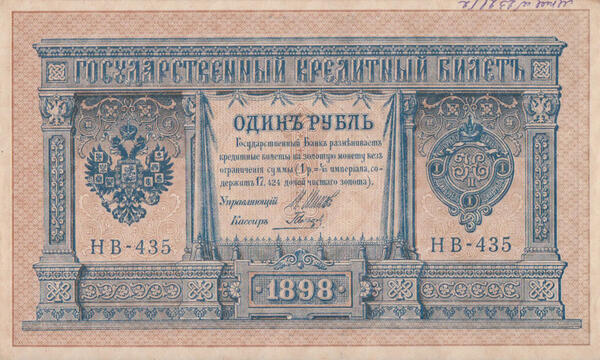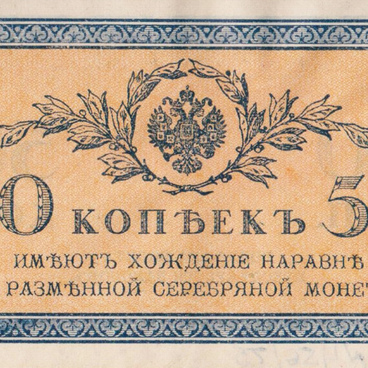One of the biggest reforms in the Russian Empire at the turn of the 20th century was the financial reform of Sergei Yulievich Witte, which introduced the gold standard — a monetary system in which the standard economic unit of account is based on a fixed quantity of gold. One of the results of this reform was the issue of a new type of banknotes.
The new type of paper money also included a one-ruble note. The design of this banknote, apart from some changes of inscriptions, was the same as that of the 1887 banknote. This banknote, as well as most other banknotes issued during the last decades of the empire, continued to be issued after the Revolution, as neither the Provisional Government nor the Bolsheviks, who replaced it, were able to quickly produce new banknotes. At the same time, the population was very distrustful of paper money during the First World War, the Revolution and the Russian Civil War, as it seriously devalued. Irrespective of the year of issue, all banknotes bear the year of introduction of this type — 1898.
The purchasing power of the ruble at the turn of the 20th century was changing. The Russo-Japanese war, the Revolution of 1905–1907, the First World War, the Russian Civil War, the difficult situation of the country at the turn of the 1920s — all these events had an adverse impact on the ruble.
The ruble was quite a high denomination in the early 20th century, representing a significant amount of money for a large part of the population. On average, at the beginning of the century, it could buy 4 kilos of wheat flour, 16 kilos of rye flour, over 6 kilos of fresh potatoes and 4 kilos of sugar. Not every farmer was able to buy a cow and the prices varied, but a minimum of 10 rubles had to be paid. One ruble could easily be spent for lunch in a good inn. Salaries of ordinary peasants and workers varied greatly from region to region, depending on the type of work performed and averaged 25–35 rubles per month. This means that the most essential things for peasants and workers were not as cheap as they seemed to be at first. Such a wage allowed the worker to live, but without excess and luxury. The peasants, who often left for seasonal work, could also rely on their land, if they managed to do some summer work on it. Nevertheless, the ruble retained its high value until the First World War, which demonstrates the success of the reform carried out by Sergei Witte.
The new type of paper money also included a one-ruble note. The design of this banknote, apart from some changes of inscriptions, was the same as that of the 1887 banknote. This banknote, as well as most other banknotes issued during the last decades of the empire, continued to be issued after the Revolution, as neither the Provisional Government nor the Bolsheviks, who replaced it, were able to quickly produce new banknotes. At the same time, the population was very distrustful of paper money during the First World War, the Revolution and the Russian Civil War, as it seriously devalued. Irrespective of the year of issue, all banknotes bear the year of introduction of this type — 1898.
The purchasing power of the ruble at the turn of the 20th century was changing. The Russo-Japanese war, the Revolution of 1905–1907, the First World War, the Russian Civil War, the difficult situation of the country at the turn of the 1920s — all these events had an adverse impact on the ruble.
The ruble was quite a high denomination in the early 20th century, representing a significant amount of money for a large part of the population. On average, at the beginning of the century, it could buy 4 kilos of wheat flour, 16 kilos of rye flour, over 6 kilos of fresh potatoes and 4 kilos of sugar. Not every farmer was able to buy a cow and the prices varied, but a minimum of 10 rubles had to be paid. One ruble could easily be spent for lunch in a good inn. Salaries of ordinary peasants and workers varied greatly from region to region, depending on the type of work performed and averaged 25–35 rubles per month. This means that the most essential things for peasants and workers were not as cheap as they seemed to be at first. Such a wage allowed the worker to live, but without excess and luxury. The peasants, who often left for seasonal work, could also rely on their land, if they managed to do some summer work on it. Nevertheless, the ruble retained its high value until the First World War, which demonstrates the success of the reform carried out by Sergei Witte.




